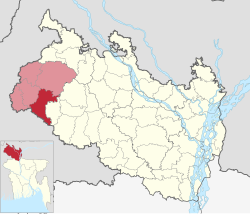|
Pirganj Upazila, Thakurgaon
Pirganj (Bengali: পীরগঞ্জ) is an upazila of Thakurgaon district in Rangpur Division, Bangladesh.[3] GeographyPirganj Upazila, having an area of 353.99 sq km, is located in between 25°40' and 25°59' north latitudes and in between 88°15' and 88°22' east longitudes. The upazila is bounded by Thakurgaon Sadar Upazila in the north, Birganj and Bochaganj upazilas in Dinajpur District in the east, Kaliaganj and Hemtabad CD blocks in Uttar Dinajpur district, West Bengal, India, in the south and Ranisankail Upazila in the west.[4][5] DemographicsAccording to the 2011 Census of Bangladesh, Pirganj Upazila had 58,299 households and a population of 243,535. 55,284 (22.70%) were under 10 years of age. Pirganj had a literacy rate (age 7 and over) of 47.81%, compared to the national average of 51.8%, and a sex ratio of 987 females per 1000 males. 27,700 (11.37%) lived in urban areas.[7] Ethnic population was 2,379 (0.98%), of which Santal were 2,232.[8] As of the 1991 Bangladesh census, Pirganj has a population of 183,292 spread across 35,912 households. Males constituted 51.69% of the population and females 48.31%. This upazila's eighteen up population is 92,296. Pirganj has an average literacy rate of 29.3% (7+ years), and the national average of 32.4% literate.[9] AdministrationPirganj was primarily formed as a thana in 1870 and converted into an upazila on 7 November 1983. Pirganj Upazila is divided into Pirganj Municipality and ten union parishads: Bairchuna, Bhomradaha, Daulatpur, Hazipur, Jabarhat, Khangaon, Kosharaniganj, Pirganj, Saidpur, and Sengaon. The union parishads are subdivided into 168 mauzas and 168 villages.[7] EducationPirganj has a number of schools and colleges has quite popular around the whole district. The education system is divided into five levels: primary (from grades 1 to 5), junior (from grades 6 to 8), secondary (from grades 9 to 10), higher secondary (from grades 11 to 12) and tertiary.[11] The five years of primary education concludes with a Primary School Completion (PSC) Examination, the three years of junior education concludes with Junior School Certificate (JSC) Examination. Next, two years of secondary education concludes with a Secondary School Certificate (SSC) Examination. Students who pass this examination proceed to two years of higher secondary or intermediate training, which culminate in a Higher Secondary School Certificate (HSC) Examination.[11] Education is mainly offered in Bengali. However, English is also widely taught and used. Many Muslim families send their children to attend part-time courses or even to pursue full-time religious education alongside other subjects, which is imparted in Bengali and Arabic in schools, colleges and madrasas.[11] RiversThere are 3 rivers in Pirganj upazila namely, Tangon River, Kahalai river and Lachchi river.  See alsoReferences
|
||||||||||||||||||||||||||||||||
Portal di Ensiklopedia Dunia


